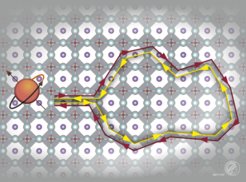Spin trumps pseudospin in a Dirac antiperovskite
Measurements of weak antilocalization in Sr3SnO reveal a "hidden" spin-momentum entanglement.
Quantum mechanics blurs the distinction between particles and waves. A rather exotic manifestation of the wavelike nature of electrons in solids, revealed by a simple measurement of electrical resistance, is weak localization. The probability of an electron propagating from points A to B is determined by summing the complex quantum-mechanical amplitude of every possible path. When points A and B are identical (closed loop), the probability is enhanced due to constructive interference between clockwise and counterclockwise paths that always return with matching phases. Hence, there is an extra probability for an electron to remain in its position (i.e., localized), resulting in a positive correction to the resistivity at low temperatures and zero magnetic field (weak localization).

The opposite is also possible: in some solids, a phase shift could occur between the two time-reversed paths, resulting in weak antilocalization. Traditionally, antilocalization has been attributed to the spin-orbit coupling in a material, but this is sometimes misleading. An interesting recent example is graphene, where electrons acquire such a phase shift by going around one of the Dirac points in momentum (k) space. This extra phase, which the electrons obtain by encircling a singular point in k-space, comes from pseudospin, and gives rise to destructive interference for closed-loop paths. An open question is what happens in a solid where both real spin and pseudospin are at play. In the case of graphene, the spin-orbit coupling of the light carbon atoms is too small, so pseudospin trumps real spin in the generation of weak antilocalization.
It turns out that the antiperovskites, or inverse perovskites, with chemical formula A3BO (A = Ca, Sr, Ba, Eu; B = Sn, Pb), provide a suitable test platform [1]. In these compounds, exotic chemistry befriends exotic physics. Compared to the normal perovskites, the positions of the cations and anions are exchanged, forcing the B atom (Sn, Pb) into an unusual anionic state where its valence p-shell is nearly filled [2]. It is precisely this nearly complete occupation of the B p-orbitals that leads to band inversion at the Fermi energy and the generation of six massive, three-dimensional Dirac cones. The Dirac electrons are the source of various exotic phenomena, including a giant orbital diamagnetism recently reported [3]. Thus, in the antiperovskites, both the pseudospin (associated with the Dirac electrons) and real spin (from the spin-orbit coupling of the heavier B elements) degrees of freedom can be active.
Nakamura et al. observed signatures of weak antilocalization in thin films of Sr3SnO grown by molecular beam epitaxy (MBE). By fitting the data to a three-dimensional (anti)localization model newly developed by colleagues in the Quantum Many-Body Theory Department, the authors found that intervalley scattering suppresses the role of pseudospin in generating weak antilocalization. Instead, the weak antilocalization arises from a “hidden” entanglement of real spin with momentum.
A final note for expert readers: materials with strong spin-orbit coupling do not automatically manifest weak antilocalization, and sometimes exhibit weak localization instead. It is crucial to consider concrete phase-acquiring processes that can generate a phase shift as electrons walk around k-space. We showed that in the antiperovskites, the six-axial spin-orbital texture (Fig. 7 of manuscript) indeed generates a phase shift consistent with antilocalization. The suppressed pseudospin helps bring such an exotic geometrical phase pattern in a Dirac material to the forefront.
References:
[1] J. Nuss, C. Mühle, K. Hayama, V. Abdolazimi and H. Takagi
Tilting structures in inverse perovskites, M3TtO (M = Ca, Sr, Ba, Eu; Tt = Si, Ge, Sn, Pb)
Acta Crystallographica B 71, 300-312 (2015)
[2] D. Huang, H. Nakamura, K. Küster, A. Yaresko, D. Samal, N. B. M. Schröter, V. N. Strocov, U. Starke, H. Takagi
Unusual valence state in the antiperovskites Sr3SnO and Sr3PbO revealed by x-ray photoelectron spectroscopy
Physical Review Materials 3, 124203 (2019)
[3] S. Suetsugu, K. Kitagawa, T. Kariyado, A.W. Rost, J. Nuss, C. Mühle, M. Ogata, H. Takagi
Giant orbital diamagnetism of three-dimensional Dirac electrons in Sr3PbO antiperovskite
Physical Review B 103, 115117 (2021)
Jürgen Nuss











